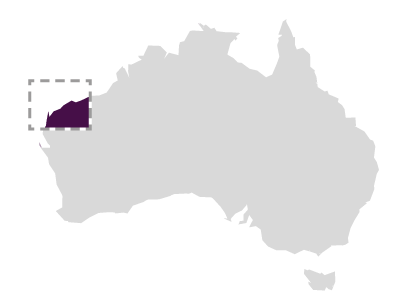Koolama I (13941)
Wyndham

On 20 February 1942 the Koolama was attacked by Japanese bombers off Cape Ruilhieres, approximately 150 kilometres west of Wyndham while carrying 91 passengers, 89 crew and a cargo of war supplies destined for the Australian Army at Wyndham. It was the first aerial attack by the Japanese in the Kimberley region of Western Australia. The Japanese flew a total of 22 air attacks in the Kimberley region from bases in Timor between 20 February 1942 and July 1944, including five raids on Broome that destroyed 23 aircraft and resulted in the loss of some 100 lives.
The Koolama was damaged in the attack and though partially disabled, was able to be beached nearby in what is now known as Koolama Bay. Fortunately no lives were lost though some passengers and crew were wounded in the attack. The Koolama was bombed again the next day, but was able to send radio SOS signals. However the bombing of Darwin by the Japanese on 19 February delayed an official rescue response to this remote area.
Meanwhile the 180 passengers and crew were landed among the mangroves at Pangali Cove, where the local Kwini people found them and sent messages via runners between Pago Mission and the survivors’ camp, separated by 80 kilometres of rough country . The Pago Mission lugger arrived on 24 February and took away the sick, wounded, women and an infant with his parents a few days after the bombing. A seaplane arrived on 3 March and was able to evacuate a further 25 survivors. The remaining 93 survivors walked to Pago Mission guided by Kwini people. During this stage two Kwini men risked their lives to cross the flooding Drysdale River, run to Pago Mission and return with a rope to help the survivors across (Balanggarra Native Title Working Group).
With the large number of extra people stretching resources at Pago Mission the decision was made to walk everyone another 30 kilometres to the airstrip at Kalumburu Mission for evacuation, during which time one crew member died of heatstroke. Most of the passengers and crew arrived at Fremantle on 8 April, 47 days after the initial attack. Father Seraphim Sanz of Kalumburu Mission won laurels for his part in rescuing the stranded passengers and crew of the Koolama and bringing them to the mission in the Mission’s lugger Moa.
Meanwhile a skeleton crew stayed aboard the Koolama and after patching the hull and pumping out water on 1 March the Koolama was refloated and able to limp to Wyndham, where it arrived without steering and taking on water. Another Japanese attack on 3 March forced all hands to abandon ship and the Koolama was bombed and sunk at Wyndham wharf.
This was a double blow as not only had a vital link between the northern and southern part of Western Australia been lost, but a strategically important waterway and port had been partially blocked causing disruption to shipping and supply of war materials.
Difficult environmental conditions including strong tidal currents meant that the Koolama was never fully salvaged. A major salvage effort using over a hundred men (including helmet divers from Australia and India), plant and gear in 1946 succeeded in cutting holes in the ship’s hull and pumping in compressed air, with the aim of raising the hull keel up and towing it several kilometres away from the wharf or out to sea to be scuttled. However this attempt only succeeded in moving the wreck 47 feet further out from the wharf and depositing it across the natural tidal flow of the Cambridge Gulf. The Koolama remains in this position today with the hull and part of its war cargo (mainly foodstuffs) intact. A multi-beam survey by the Department of Transport conducted in 2010 shows the wreck lying on its starboard side with the port side almost totally exposed and intact for the entire length of the hull, and the starboard side buried. The hull comes to within 3.7 m of the surface at lowest astronomical tide (LAT). An unexploded Japanese bomb is believed to still lie within the wreck (Loane 1992: 1)
Statement of significance
The wreck of the MV Koolama has historic and social significance for its role as a State ship transporting passengers and cargo between Fremantle and the north-west ports of Western Australia between 1938-1942.
The Koolama has historic significance as a World War II site, indicating the impact of World War II in north-west Western Australia and the strategic significance of shipping and the north-west port of Wyndham. It is also the site of the first aerial attack by Japanese forces in the Kimberley area.
The MV Koolama stranding site and survivor camp at Koolama Bay and Pangali Cove is significant to the Kwini people who helped the 180 passengers and crew reach safety.
Ship Built
Owner Western Australian State Shipping Service
Master Captain Jack Eggleston
Builder Harland and Wolff Ltd
Country Built Scotland
Port Built Glasgow
Port Registered Fremantle
When Built 1938
Ship Lost
Grouped Region North-West
Sinking Earlier bombed off Cape Rulhieres by 4 engine Japanese bombers in Joseph Bonaparte Gulf on 1942/02/20. 1942/03/03 attacked at Wyndham jetty and rolled on side, a total wreck.
Crew 90
When Lost 13941
Where Lost Wyndham
Latitude -15.4497833333
Longitude 128.1010666667
Position Information Aerial GIS
Port From Fremantle
Port To Darwin
Minimum Depth of site 4.00
Length of site 106.00
Ship Details
Engine Twin diesel engines made by Bermister and Wain, 808 nhp
Length 106.00
Beam 17.00
TONA 4068.00
TONB 2113.00
Draft 6.00
Museum Reference
Official Number 140184
Unique Number 863
Sunk Code Foundered
File Number 2009/0142/SG _MA-10/96
Chart Number 1047, 32
Protected Not protected State
Found Y
Inspected N
Confidential NO